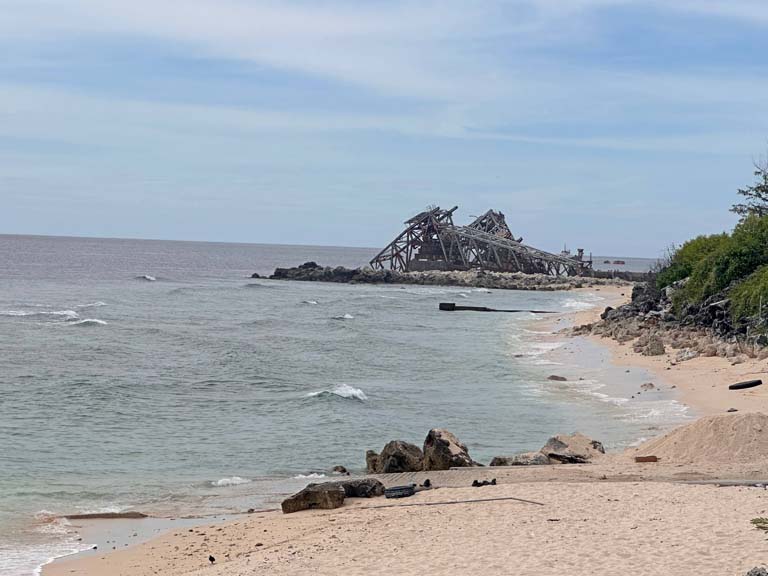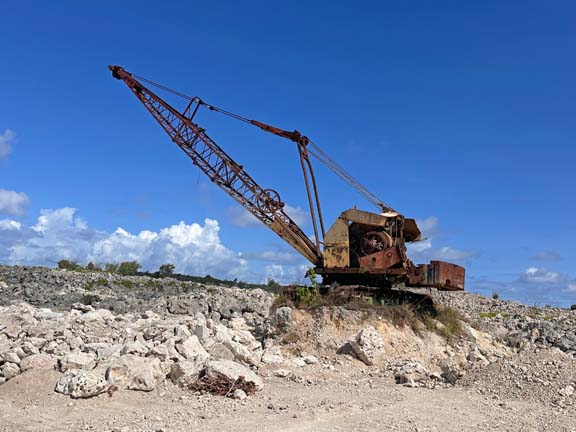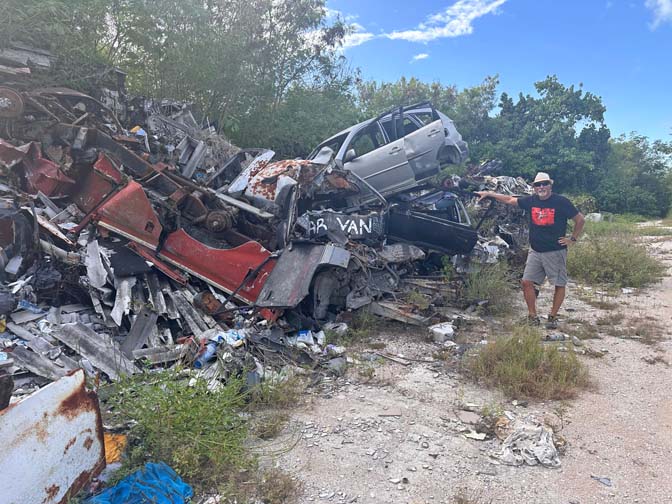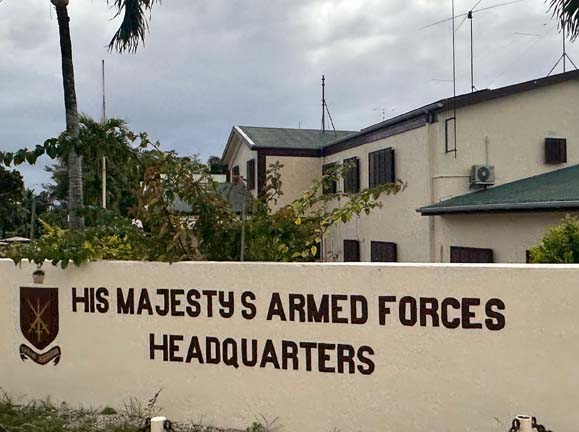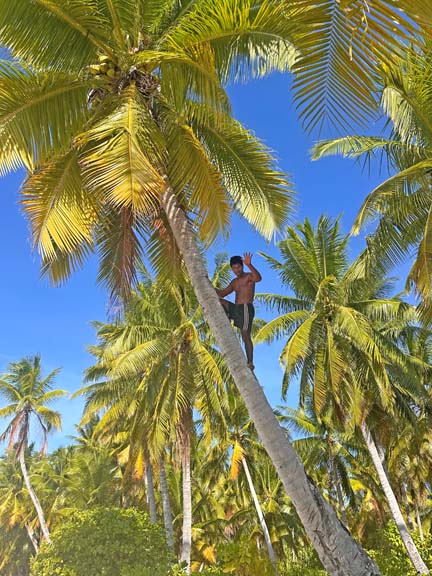
A year ago I snagged four of the Pacific island nations. Seven left to go. As many places have but once-a-week air service, it difficult to work out the logistics for visiting all the rest. My initial elaborate plan was rendered inoperative when Nauru Airlines revamped their schedule on three weeks notice and all of a sudden I was scheduled to be departing a country before I even arrived. I rejigger the flights and am able to salvage most of my original itinerary encompassing all three ethnographic regions: Polynesia, Micronesia, and Melanesia.
I start by flying once again to Fiji, the region's principal air hub. During the first layover, I assent to an evening at the Fiji Culture Village, a tourist trap where a tour of traditional huts and a mediocre "feast" are supplemented by a fairly entertaining dance show.
|
|
|
|
|
From there the first stop is Tarawa, capital of Kiribati. Formerly the Gilbert Islands, the country consists of 32 atolls totaling 300 square miles spread over 1.3 million square miles of ocean and straddling both the equator and the 180th meridian, making it the only country to occupy all four geographic quadrants. Fun fact: the grass skirts we associate with hula dancing are not even slighty Hawaiian; they originated here and were adopted by Hawaiian dance troupes touring the US mainland.
|
|
|
|
|
Tarawa entered history in November 1943. After an unopposed landing on the beach at Guadalcanal in the Solomon Islands, the US Marines were ready for a repeat; the Japanese had something else in mind. The 3,000 defenders and their four obsolete eight-inch guns from the Russo-Japanese War faced an invasion force of 35,000 and a flotilla of 17 aircraft carriers, 12 battleships, and 100+ other warships. The Japanese fought almost to the last man in one of the bloodiest battles of the Pacific war. Unwarranted expectations and much misplanning by the US led to many lessons learned. Most of the battle took place on the beach at Betio Island where two of the Japanese guns remain as a memorial.
|
|
|
|
|
The economy consists of coconuts, fishing, and foreign aid.
|
|
|
|
|
An atoll is a ring-shaped island or series of islands encircling a lagoon. The chain of narrow islets known as South Tarawa are connected by a causeway. Due to a dearth of available accommodation, we stay on North Tarawa in an overwater bungalow. The road being in less than ideal condition, we get there by boat.
|
|
|
|
|
One of the activities is catching mantis shrimp at low tide. This is a skilled art: the guy looks for hidey-holes on the lagoon floor and marks them with a slender stick. He later returns with a baited string to lure the carnivorous crustaceans from their burrows-and catches them with a swift scoop of his net. The resulting catch makes for a fine dinner.
|
|
|
|
|
We wade to another island for a village visit. This is basically a subsistance economy, dependent on donations for most anything modern. Australia and New Zealand are major benefactors throughout the region including stocking village health clinics.
|
|
|
|
|
|
You want coconuts? We got coconuts!
|
|
|
|
|
We need to depart at zero dark thirty to return to the airport for an early morning flight
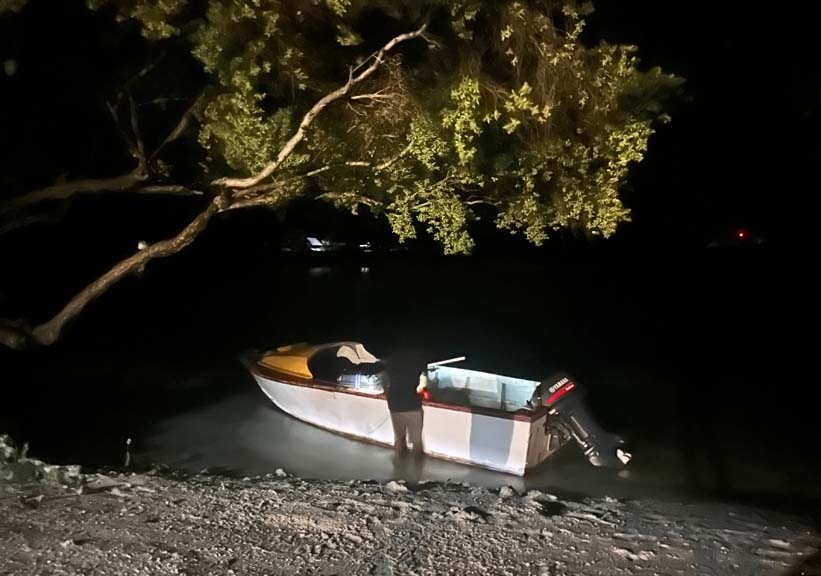
to Majuro, capital of the Marshall Islands. This part of Micronesia was administered by Germany, then by Japan, and finally by the US until gaining independence in 1979. Much like American Samoa, the atmosphere is “little USA”: the currency is the US dollar, several US government agencies have offices here, and the post office even has a zip code.
|
|
|
|
|
Majuro used to have a significant US military presence, but currently the active bases are on Kwajalein, a couple of atolls over. In the 1940’s and 50’s some 67 nuclear bombs were tested on Bikini and Enewetak atolls. A small museum depicts the transformation of life on the islands from the stone age to the atomic age in the span of a few decades. Compensation to displaced former inhabitants and persons affected by radiation still comprise a significant source of national and personal income. As one of the dwindling number of countries that recognize the Chinese Nationalist Government over the Communist regime on the mainland, they also benefit from aid from Taiwan.
|
|
|
|
|
There’s not much to do or see on Majuro. A day trip across the lagoon to a nearby island passes by a downed WWII Grumman Avenger torpedo bomber. Even though the wreck lies over 100 feet down, the crystal clear water affords a good view.

Our next stop is Nauru, the second smallest UN country.
In contrast to narrow atolls barely above sea level, Nauru is an oval-shaped island of 8 square miles and 12,000 inhabitants. It was first administered by Germany, then Japan, and then Britain until independence in 1968. I can't help but notice that early photographers here (and elsewhere in the region) tended to devote particular attention to the young ladies. The island was fortified by the Japanese but, implementing an island-hopping strategy after the Battle of Tarawa, the Americans bypassed Nauru. Guarding against an invasion that never came, there are still Japanese gun emplacements in the heights and pillboxes on the beach. Apart from a narrow coastal strip, the geography of the island is limestone pinnacles that reach into the sea. The interior of the island is a wasteland of bare pinnacles and abandoned machinery. The interior is also hosts a trove of abandoned vehicles. Money used to flow so freely that damaged or disabled cars were discarded rather than repaired. There are probably more abandoned vehicles on Nauru than operational ones. These days those inhabitants who have not decamped for Australia must get by in greatly reduced circumstances. Back to Fiji for another layover, this time in Suva, the capital, on the opposite side of the island from the international airport. Suva has a magnificent natural harbor but is surrounded by mountains; its small airport, from which our next flight departs, is some distance away. Although the city sprawls over the hills, its historic downtown is relatively compact. Tuvalu, the smallest UN country, is a true flyspeck in the Pacific: it is but ten square miles and has a population of 11,000. It formerly was the latter of the British administered Gilbert and Ellice Islands. Its principal island is Funafuti, a long narrow outcrop at times no more than 50 yards wide. Much of its real estate is taken up by the airport, a former World War II airfield from which US bombers took off to bomb the Japanese airfield at Nauru. The unfenced runway is surrounded by houses and, except during the four scheduled flights a week, serves as the principal recreation area for the populace. There is precious little to do or see on Tuvalu. That, and the cost and inconvenience of getting here, make this the least least visited country on the planet. But in 1982 Elizabeth II, as Queen of Tuvalu, made a royal visit to this, the least of her realm, and was greeted in grand Polynesian style. A plaque commemorates the occasion. Nor is Tuvalu (and its vote in the UN) too small to get notice (and aid) from Taiwan The Pacific micro-states are leaders in the global warming grift. Rather than outright asking for alms, they wave the banner of climate change and demand huge wealth transfers from the developed world (which, if it actually happened, would likely go the way of Nauru's phosphate windfall). In the meanwhile, the scam provides an excuse for meaningless employment and international travel. And, should you need a new SUV, you can call on the EU and make known your need for a climate change emergency mobile response unit. It's back to Fiji for a flight to Tonga, the final country on this trip. The kingdom has a distinction of being the only island group in Oceania never to have been colonized. Although no longer an absolute monarchy, Tonga retains its ancient feudal system of government and land tenure. What was essentially a tribal chief adopted the trappings of European monarchs and everyone, except perhaps the commoners, seemed happy to play along until 2006, when pro-democracy riots burned down 80% of the central business district of the capital, Nuku'alofa. The Royal Palace is on the seafront in the center of the city. The sights of Tongatapu, the main island, include a 13th century trilithon often called "The Stonehenge of the Pacific," a natural bridge, and an area of coastal blowholes. That's it. An abbreviated itinerary of five countries in three weeks. Lots of sand and ocean, fish and coconuts, but lacking in terms of exotic natives. Trip date: September, October 2024 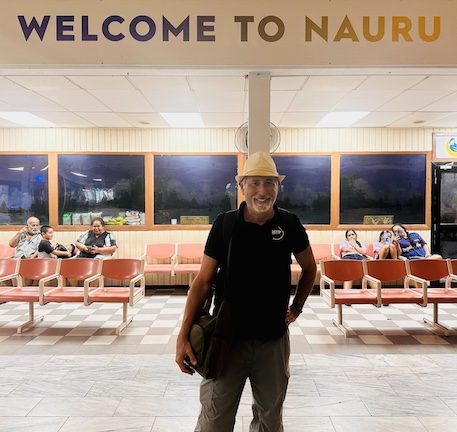







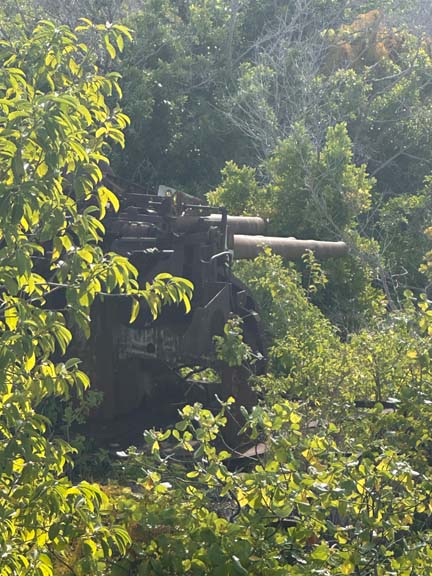

The story of Nauru can be summed up in one word: phosphate. Millions of years of accumulated bird poop covered the interior of the island with this easily-recovered resource. Strip mining from the early 1900’s until its exhaustion in the 1980’s created great wealth, frittered away through profligate spending and improvident investments. Rusting and collapsed ruins are all that remain of the port loading facilities.

